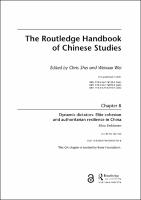Chapter 8 Dynamic dictators
Proposal review
Elite cohesion and authoritarian resilience in China
Abstract
This chapter provides a framework for understanding changing levels of power concentration and how they might be linked with authoritarian resilience. It looks at elite level dynamics in China and discusses elements of power concentration including personalization, administrative centralization, and state control over economic assets. There is a general trend of deepening autocratization during Xi Jinping’s regime. Institutional arrangements in existing institutions such as Party bodies and the People’s Liberation Army, innovation of new institutions, and purges of opponents show a clear trend of power concentration. Before the Xi era, the central government shared power with regional administrations and China’s level of fiscal decentralization was relatively high in international comparison. More recently, the tide has turned towards increasing centralization. In the economic realm, China’s development model has many features ensuring Party control. New forms of control such as the social credit system have emerged along with traditional measures, such as state control of the financial sector and special arrangements guiding state-owned companies.
Keywords
Chinese, language learning, foreign policy, Chinese political system, domestic governance, international relations, Chinese culture, Chinese literature, Chinese history, Chinese sociology, Chinese opposition, Chinese activism, Chinese people, Chinese society, Chinese studiesDOI
10.4324/9780429059704-8ISBN
9780367181390, 9780367760908, 9780429059704Publisher
Taylor & FrancisPublisher website
https://taylorandfrancis.com/Publication date and place
2021Imprint
RoutledgeClassification
Language
Language: reference & general
Language and Linguistics
Language: reference and general


 Download
Download Web Shop
Web Shop